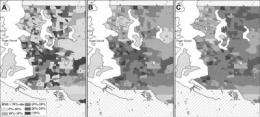Childhood obesity linked to neighborhood social and economic status

Children in King County, Washington, are more likely to be obese if they live in socially disadvantaged neighborhoods. This is according to a team of researchers at Seattle Children's Research Institute, the University of Washington (UW), and Group Health Research Institute. Social Science & Medicine e-published the research this week in advance of printing it.
The researchers found obesity most common in children living in neighborhoods with the least-educated females, most single-parent households, lowest median household income, highest proportion of non-white residents, and fewest homes owned. Together, these five socioeconomic factors accounted for 24 percent of the variability in childhood obesity rates across neighborhoods.
"What we found confirms that it takes a village to raise a child," said lead author H. Mollie Greves Grow, MD MPH, an assistant professor of pediatrics at the UW, Seattle Children's, and Harborview Medical Center. "Children are raised not only at home but also in their community." Disadvantaged neighborhoods may present many obstacles for children's weight, such as less access to healthy foods and more unhealthy fast-food outlets. They also often lack safe places for children to play outdoors.
"Childhood obesity is not just a family problem, but a larger community and societal problem," Dr. Grow added. "A disadvantaged environment can set families up for ill health, and it's unfair to blame them for not taking enough 'personal responsibility' to manage their weight. We don't yet know all of the factors that may create disadvantage, but we know it is present and associated with higher obesity."
The research team collected anonymous, "de-identified" electronic medical record information on 8,616 children age 6-18 receiving care at Group Health Cooperative—and then correlated these data to the social and economic characteristics of Seattle-area census tracts.
This study of childhood obesity helped overcome the limitations of previous studies by using weight measurements pulled from medical records, not self-reported by study subjects. Self-reporting is often less accurate. This was the first study evaluating childhood obesity to use rigorous statistical methods of spatial modeling to smooth out differences based on arbitrary census tract lines. Using this technique helped provide a more accurate effect of neighborhoods on children's weight.
"We were a little surprised that each of the census tract factors we included appeared to contribute, in a slightly different way, to the likelihood of childhood obesity," Dr. Grow said. The likelihood of childhood obesity rose by 17 percent to 24 percent for each of three measures of neighborhood social disadvantage: each 10 percent decrease in female education and two-parent households, and each $10,000 decline in household income. Effects related to race and homeownership were smaller but still statistically significant.
Overall, King County's demographics resemble those of other urban U.S. areas. "But King County has one of the strongest public health efforts, a relatively walkable environment, and efforts to expand affordable access to healthy, fresh foods," said Dr. Grow. So she and her colleagues expect the links between childhood obesity and neighborhood disadvantage may be even more pronounced elsewhere.
Dr. Grow and her coauthors are not only continuing to study how neighborhoods with low socioeconomic status raise the risk of childhood obesity.
"I have seen some resilient families beat the odds by boosting their children's health despite their environment, and I hope to help other families do the same," Dr. Grow said. "Still, even more health gains would come from narrowing the inequality gaps that have been widening between rich and poor in this country. We should strive for all families to have access to walkable neighborhoods, safe parks, healthy grocery store options, and active schools. Tax dollars, voters, community planners, builders, and green spaces can all help make an impact."
More information: Paper: dx.doi.org/10.1016/j.socscimed.2010.04.018














